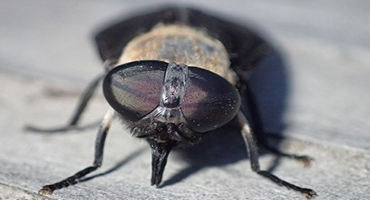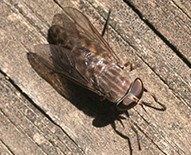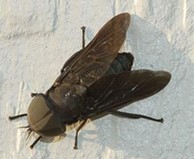By Patrick Wagner, Amanda Bachmann and Adam Varenhorst

Horse Fly Activity
As we progress later into the summer, we commonly see an increase in horse fly activity. These large flies can be found throughout South Dakota; however, they are typically more of an issue in the Southern and Eastern portions of the state. Horse flies have the ability to inflict a very painful bite and draw large amounts of blood. If present in high populations, they can become a significant pest of pastured livestock, primarily cattle and horses.
Identification
Horse flies can be easily identified by their large size compared to other common fly pests such as stable flies or horn flies. Most species are approximately ½ of an inch to 1 ¼ inches in length. Horse flies have a robust body that is usually covered with small hairs. They have a pair of large compound eyes on the head and prominent mouthparts that extend downward (Figure 1). Horse flies vary in color, with many being black, grey, or brown and some having patterns of blue, green, or yellow. Most species are multicolored with stripes on the abdomen and thorax (Figure 2). Horse flies can also be uniformly colored, including the eyes and wings (Figure 3).


Fig. 2. Horse fly (Tabanus abactor) Fig. 3. Black horse fly (Tabanus atratus)
Lifecycle & Behavior
In South Dakota, adult horseflies start emerging in early summer and remain active for 6 to 8 weeks. The flies will feed on nectar until they mate, after which the females will feed on blood. Much like mosquitos, female horse flies require blood meals in order to develop eggs. The females lay their eggs on vegetation in streams and wetlands. Larvae will hatch a few days later and drop down into water or saturated soil to complete their development. Most horse fly species only have one generation per year. They overwinter as larvae, pupate, and emerge as new adults the following year.
Horse flies primarily feed on larger animals, including cattle and horses. They mostly rely on visual cues to seek out hosts, searching for large, dark, moving objects. Horseflies are capable of consuming large amounts of blood, leading to animal stress and reduced weight gain. They can also be disease vectors and potentially cause further harm to affected livestock.
Management
Managing horse flies can be very challenging. Horse fly larvae cannot be eliminated without risking permanent damage to sensitive wetland ecosystems.
Click here to see more...